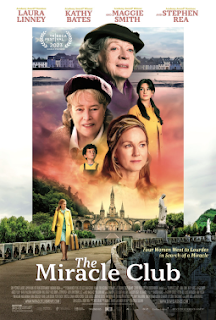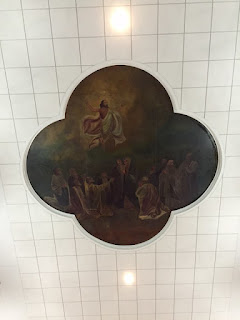I have been to Lourdes three times in my life, each occasion as part of a group pilgrimage, and I consider those pilgrimages to that holy shrine among my most cherished priestly memories. So it was with a mixture of eagerness (to see how a pilgrimage to Lourdes would be depicted in film) and anxiety (worry about how a pilgrimage to Lourdes would be depicted in film). The Miracle Club (directed by Thaddeus O’Sullivan) captures Lourdes if not devoutly at least experientially. (One thing very accurate about the movie is how cold the water is. The first time I went to Lourdes was in November, which to me at the time seemed like sufficient explanation of the cold. The water was so cold that my teeth actually chattered as I attempted to make the required responses to the prescribed prayers.)
Set in 1967 Ireland, The Miracle Club is about an assortment of working-class Dublin women – Lily (Maggie Smith), Eileen (Kathy Bates), Dolly (Agnes O’Casey), and Chrissie (Laura Linney) – who have all known each other for decades, who for various and different reasons embark together on a pilgrimage to the shrine of Lourdes.
The setting is a presumably typical Catholic parish of that place and time, which sponsors a pilgrimage to Lourdes as a prize at a community fundraiser talent show, at which Lily, Eileen, and Dolly perform together. Each has a moderately difficult husband and the predictably demanding kind of family situation which we are programmed to suspect in such a stereotypically patriarchal cultural and religious setting. At this parish fundraiser, suddenly appears Chrissie, the long-absent daughter of the three women’s dear friend Maureen, who has just died and whose funeral will be the next day. It turns out that Chrissie has been away for 40 years and has been alienated not only from her mother but also from Lily (who turns out to have been the mother of her long-dead boyfriend) and Eileen (who is her cousin and was once her best friend). Amazingly, after 40 years, they all recognize each other immediately. The reason for the history of hostility is not immediately apparent, although the plot is simple and straightforward enough that it is fairly easy to figure out the basis for much of what went wrong in these women’s lives and in their relationships with one another.
The pilgrimage to Lourdes leads them to open up about their shared history and come to terms with their mutual hurts and resentments – and their feelings of guilt. In the process they rediscover each other and rekindle long-lost friendships. The movie does not require us to believe that this itself happens as one of the shrine’s miracles, but it allows us to believe that if we are so inclined.
Two of the women did have hopes for my explicit miracles. Eileen has discovered a lump in her breast, knowledge she has so far she has kept to herself. Dolly has a 6-year old son who does not speak. Eileen does not get healed in that sense. (In fact, the experience seems to trigger a certain cynicism about religion, making her sound more like the men in these women’s lives.) But the Lourdes experience proves to be one of real reconciliation – among the four women (and also among their families back at home).
Fr. Dermot, the pastor who accompanies them on their pilgrimage is played as a quaintly conventional figure. But he does get the movie’s best line: « You come [to Lourdes] for the strength to go on when there is no miracle. »




